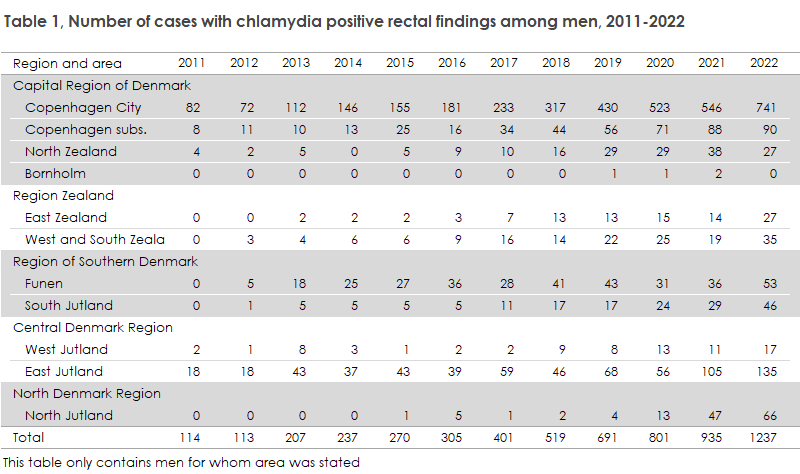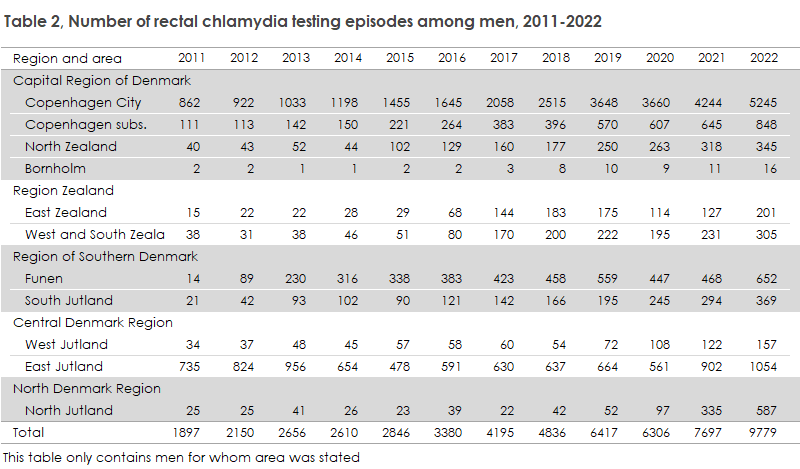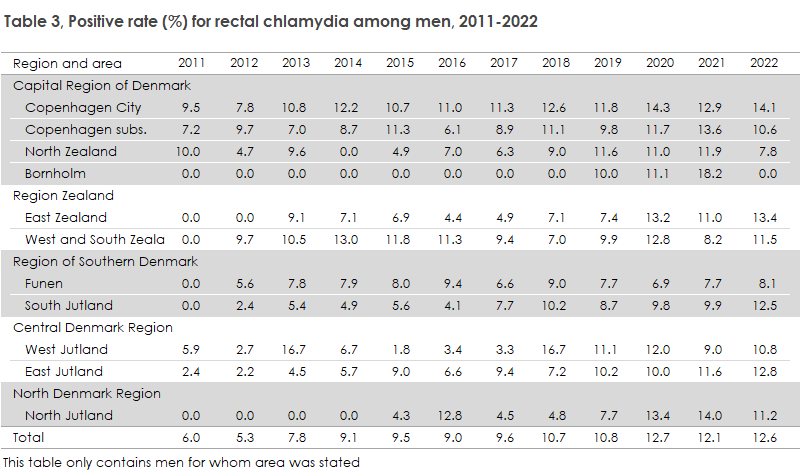No 38 - 2023
Chlamydia 2022 /
Corrected figures presenting rectal chlamydia among men, 2011-2022
Chlamydia 2022
- 2022 recorded 41,634 laboratory-confirmed chlamydia cases.
- Compared with 2021, the number of testing episodes increased by 6% and the number of chlamydia cases by 14%.
- Men comprised 42% of all detected chlamydia cases, whereas the positive rate was higher among men (19%) than among women (11%).
- The chlamydia incidence among young people aged 15-29 years of age increased from 2021 to 2022.
- A total of 86% of all chlamydia cases occurred in the 15-29-year age group. This age group should therefore be encouraged to be extra attentive to safe sex, and patients with positive tests should be instructed to undertake partner tracing.
- As the test activity is lower among men than among women and as men have a higher positive rate, men in the 15-29-year age group in particular should be encouraged to be tested.
- The male number of rectal chlamydia cases in 2022 (1,237) was higher than the corresponding number for 2021 (935).
- This issue of EPI-NEWS contains a separate section with corrected male rectal chlamydia figures for the period 2011-2022.
- The share of men with anorectal chlamydia who were tested for lymphogranuloma venereum (LGV) remained unchanged from 2021 (92%) to 2022 (91%).
- In 2019, doxycycline was recommended for treatment of uncomplicated chlamydia. The reason for this was the high occurrence of azithromycin resistance among Mycoplasma genitalium in Denmark, which was probably due to the fact that azithromycin had been the recommended standard treatment for uncomplicated chlamydia until then.
- Data extracted from the Prescriptions Register indicate that azithromycin is still being used for chlamydia treatment in approx. half of all cases. This consumption should be reduced further.
As in the preceding years, the data used to prepare the 2022 chlamydia report were collected via the Danish Microbiology Database (MiBa) and comprise all positive and negative test results for oculo-genital infection caused by Chlamydia trachomatis.
A detailed epidemiological description of the incidence of chlamydia in 2022 is available here.
Since 2021, the number of chlamydia testing episodes has increased by 6%; the number of detected chlamydia cases, by 13.7%. Thus, the positive rate has increased by 1 percentage point to 13.6%.
Apart from the age groups < 1 year and 45+ years, more than twice as many women as men are tested for chlamydia. Even so, the positive rate among men is higher than that observed for women in nearly all age groups. In 2022, the male share of detected chlamydia cases comprised 42%, which is identical to the figures recorded for 2021. Even though the share has followed a steadily increasing trend, the distribution is inexpedient, underlining the importance of increased testing activity among men of all ages.
Overall in Denmark and for nearly all Danish areas, considerably more men were tested for rectal chlamydia in 2022 than in 2021. Thus, a 27% increase in testing episodes was recorded. The number of rectal chlamydia cases recorded in 2022 (1,237) was considerably higher than that recorded in 2021 (935), and the positive rate increased by one percentage point (from 12.1% to 13.1%) compared with 2021. The positive rate increased in the following areas: Copenhagen City, East Zealand, West and South Zealand, Funen, South Jutland, West Jutland and East Jutland. In contrast, the positive rate declined from 2021 to 2022 in Copenhagen Subs, North Zealand, on Bornholm and in North Jutland. Men with rectal chlamydia should be tested for HIV, syphilis and gonorrhoea; and the sample material should be tested for the variant of C. trachomatis that may cause LGV, EPI-NEWS no. 20/2008. Among men who had rectal chlamydia detected, 91% also underwent lymphogranuloma venereum (LGV) testing. This is in line with the 92% recorded in 2021. However, the number of men who had anorectal LGV detected increased by 375% from 2021 to 2022, reaching a total of 76. Men with rectal chlamydia should be tested for HIV, syphilis and gonorrhoea; and the sample material should be tested for the variant of C. trachomatis that may cause LGV, EPI-NEWS no. 20/2008.
A total of 86% of all chlamydia cases are seen in 15-29-year-olds. However, the number of persons tested in this age group is considerably lower among men than among women. The preventive measures therefore need to be strengthened through information about safe sexual behaviour, increased sampling activity and, once chlamydia has been detected, partner tracing.
Previously, Denmark recommended azithromycin 1g given orally as a single dose for treatment of uncomplicated chlamydia. However, double infection with C. trachomatis and Mycoplasma genitalium is probably relatively frequent, and as a considerably higher occurrence of azithromycin resistance was found among M. genitalium in Denmark than in Sweden, where doxycycline is used for chlamydia treatment, Denmark decided to change the recommendation regarding chlamydia treatment in 2019. First-line treatment of uncomplicated chlamydia including uncomplicated rectal chlamydia was then changed to orally administered doxycycline 100 mg x 2 for seven days. For rectal LGV, the same dose is given, but for a 21-day period. Guidelines on the treatment of chlamydia in pregnant women and persons with complicated chlamydia cases, including epididymitis and salpingitis, are available (in Danish language) in the guidelines published by the Danish Dermatological Society on sexually transmittable infections.
(T.R. Pedersen, S. Hoffmann, A. Skafte-Holm, Department of Bacteria, Parasites & Fungi; K.D. Bjerre, Data Integration and Analysis)
Corrected figures presenting rectal chlamydia among men, 2011-2022
In connection with the preparation of the EPI-NEWS issue on chlamydia for 2022, we discovered that the tables presenting rectal chlamydia among men published in previous years included some errors.
The four tables provided below provide the corrected figures.




(T.R. Pedersen, S. Hoffmann, A. Skafte-Holm, Department of Bacteria, Parasites & Fungi; K.D. Bjerre, Data Integration and Analysis)